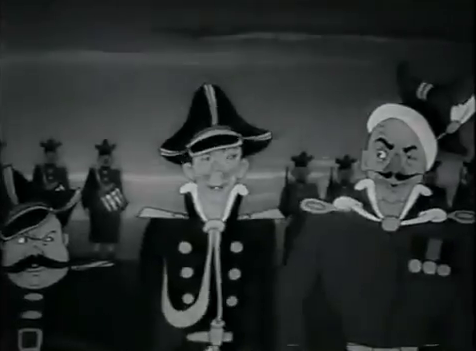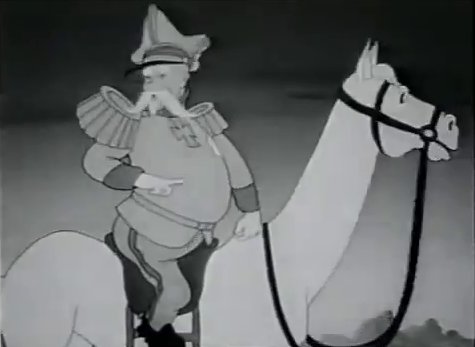The language of propaganda dominated many animated movies during World War II. The films often emphasized the otherness of an enemy, carrying in some extreme cases the signs of racism. The devices of stereotyping, animalization and caricaturing were often used in describing the enemy’s army and political leaders as well as in portraying entire nations. In this post I will show how in a totalitarian country such as the Soviet Union animation was used as a tool for controlling the emotions the society had towards its enemies by means of using it to build a certain image around the latter.
A good example of a film that gives a clear message about the Soviet Union’s enemy is the black and white, 20 minute-long cartoon Ivas (dir. Ivan Ivanov-Vano, 1940). Here, the image of the Polish soldier is used in order to explain the USSR army’s invasion of Poland on September 17th 1939. To make this animated film was the most experienced artist in the Sojuzmultfilm studio. Ivanov Vano created his first film in 1927, and subsequently gained experience by creating cartoons for children and propaganda films.
In Ivas the action takes place in the East of Poland. The film starts in a poor village inhabited by Belarusians. In the first scenes the breeding animals and the farmlands are not seen, the inhabitants are mostly old people. All begins in Autumn – the leaves fall from the trees and it’s raining. An atmosphere of sadness, low spirits and decline is created also by showing crows fly away before the eyes of a woman, who is carrying water to the village. Moreover, sound wise a very touching song, that can be understood as a kind of longing for a happy life, is used.
The nostalgic mood of the film is disrupted by the arrival of a group of Polish soldiers in the village. The device of caricature is used in portraying them. Their dark uniforms differ from the light ones of Belarusian peasants. They also wear a mustache, a choice that is linked to Poland’s Sarmatic culture. Besides some private soldiers, four commanders are introduced in the film: a corporal, a lieutenant, a colonel and a general. Their image is made comical by combining many different techniques of drawing. The corporal is drawn as a very fat and small men, a fact that has him recall to the mind a pig. The lieutenant is tall and skinny and, what’s more, his face with the tinny mustache recalls a rat’s snout. The colonel wears a cape, an element stereotypically associated to Polish nobleman. Additionally the color of his nose points to his drunken nature.
There is also a general sitting on horseback. He is so small that his horse needs to carry a ladder. Besides their appearance, also the way in which they move and act is comical and grotesque. The general, holding an umbrella in his hand, walks as if he was dancing. The corporal makes an exaggerated gesture to adjust his mustache. The lieutenant behaves like a woman and, every time he is given an order, he always claps his hands and smells a flower that he holds in his hand.
Sound too is used to confer a grotesque character to the various soldiers. The commanders often make their statements in a broken Polish within conversations in Russian. All the way through the film the corporal counts “One, two” at a constant rhythm, in order to urge for his commends to be carried out. In moments of anger he calls out “Holly Marry!”, an exclamation that introduces a stereotype linked to Polish Catholics. When facing moments of failure the colonel says “Dammit”, whereas the general mostly says “I don’t understand” and that makes his image seem foolish. In this way not only the image of the Polish people is being deformed, but also the Polish language could be seen by the Russian spectators as funny and unnatural. What’s more the music accompanying the Polish soldiers is much simpler in comparison to the classical and sublime one describing the Byelorussian soldiers. There is a good example of this in the first scene when, after the romantic and exalted song, comes up the marching music of pipes played by the Polish force. Thus the whole image of “Polish nobleman” becomes the main motive in the film.
Ivas is only one example of the way Russian animation built the propaganda message during World War II. More precisely, Ivanov-Vano’s animation just anticipated the “animated attack” on the Nazi invader that the Russians artists would have conducted after Operation Barbarossa in June 1941.
Michał Mróz is a film director, animator, graphic designer and animation historian. He holds a Master’s degree in Culture Studies from University of Warsaw and a graphic designer diploma from Warsaw School of Advertising. Currently he is a Ph.D. student at the Institute of Polish Culture, University of Warsaw. He participates in a Film Research Team. His dissertation focuses on the animated films created during World War II. He is also interested in the language and aesthetics of animation. Mróz is also the author of short animated films and the winner of multiple awards. He lectures in Warsaw School of Advertising in the Department of Animation Studies. He is the workshops leader in many educational projects such as social rehabilitation activities based on creating puppet animated films. He has received the artistic scholarship of Warsaw and Adam Mickiewicz Institute. His website is: https://www.michalmroz.eu



26 comments for “The Negative Image of Poles in the Propaganda Animated Film Ivas”